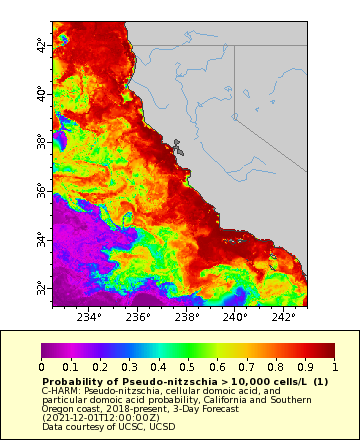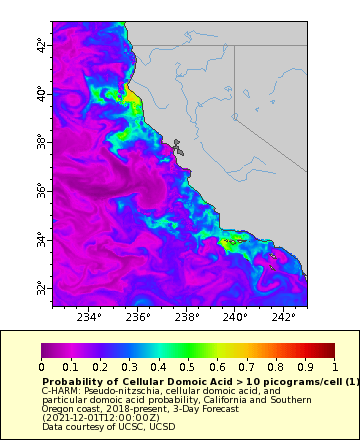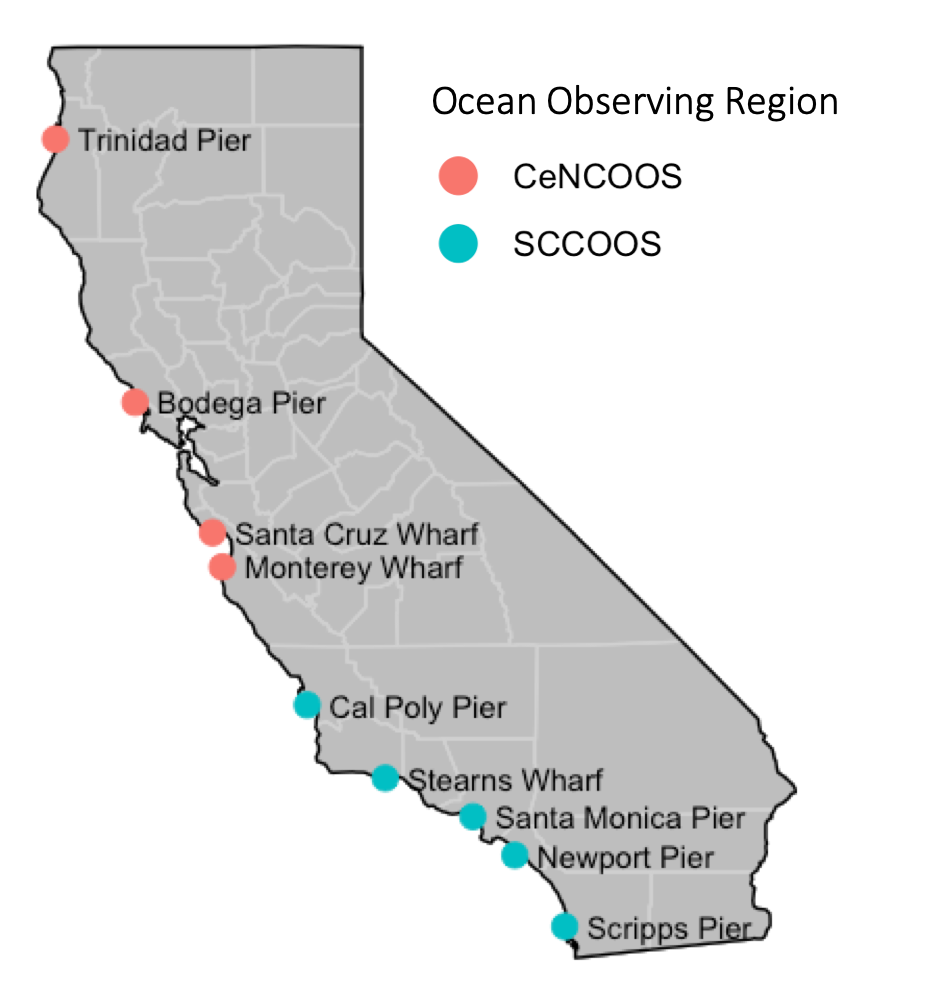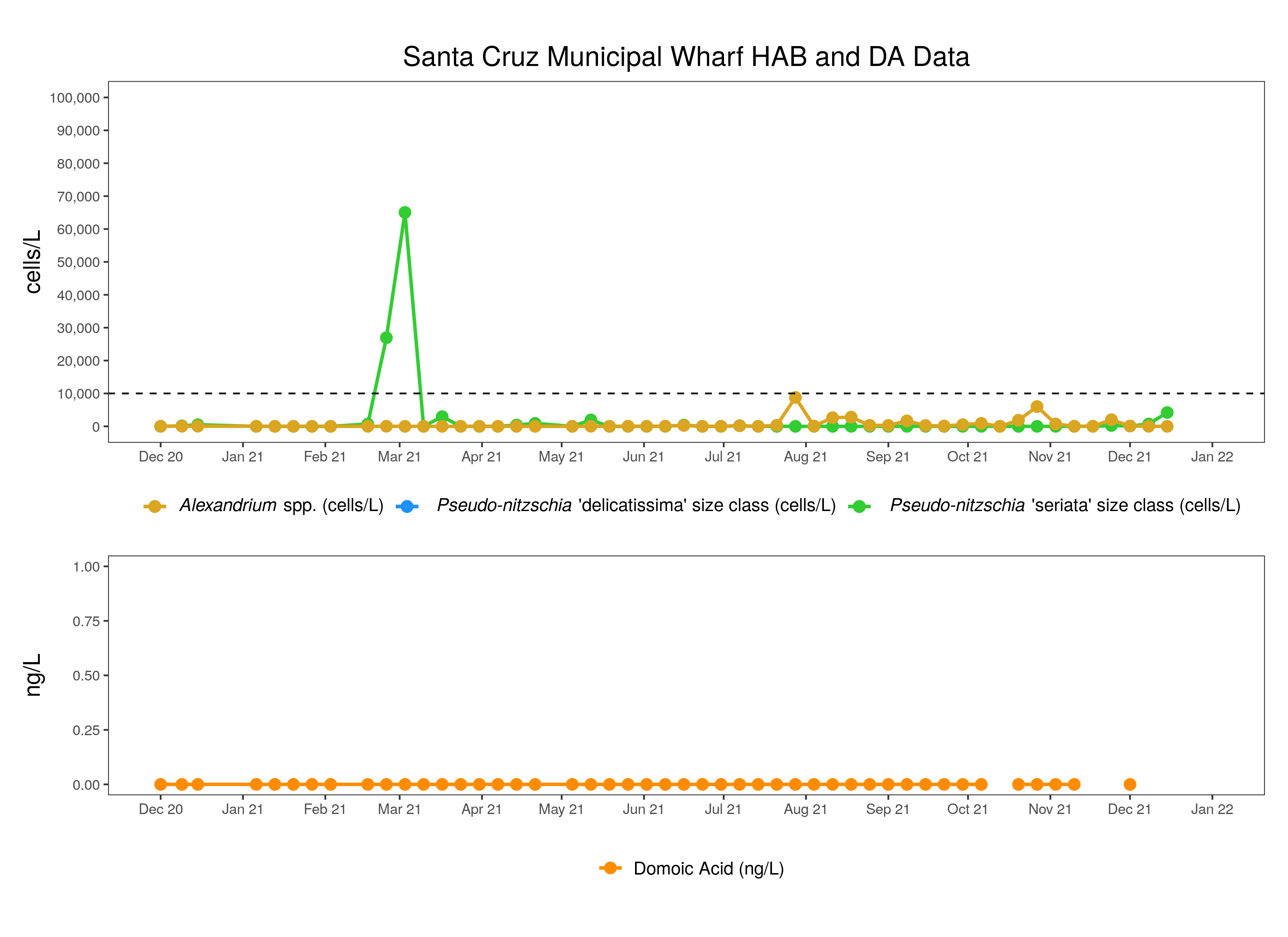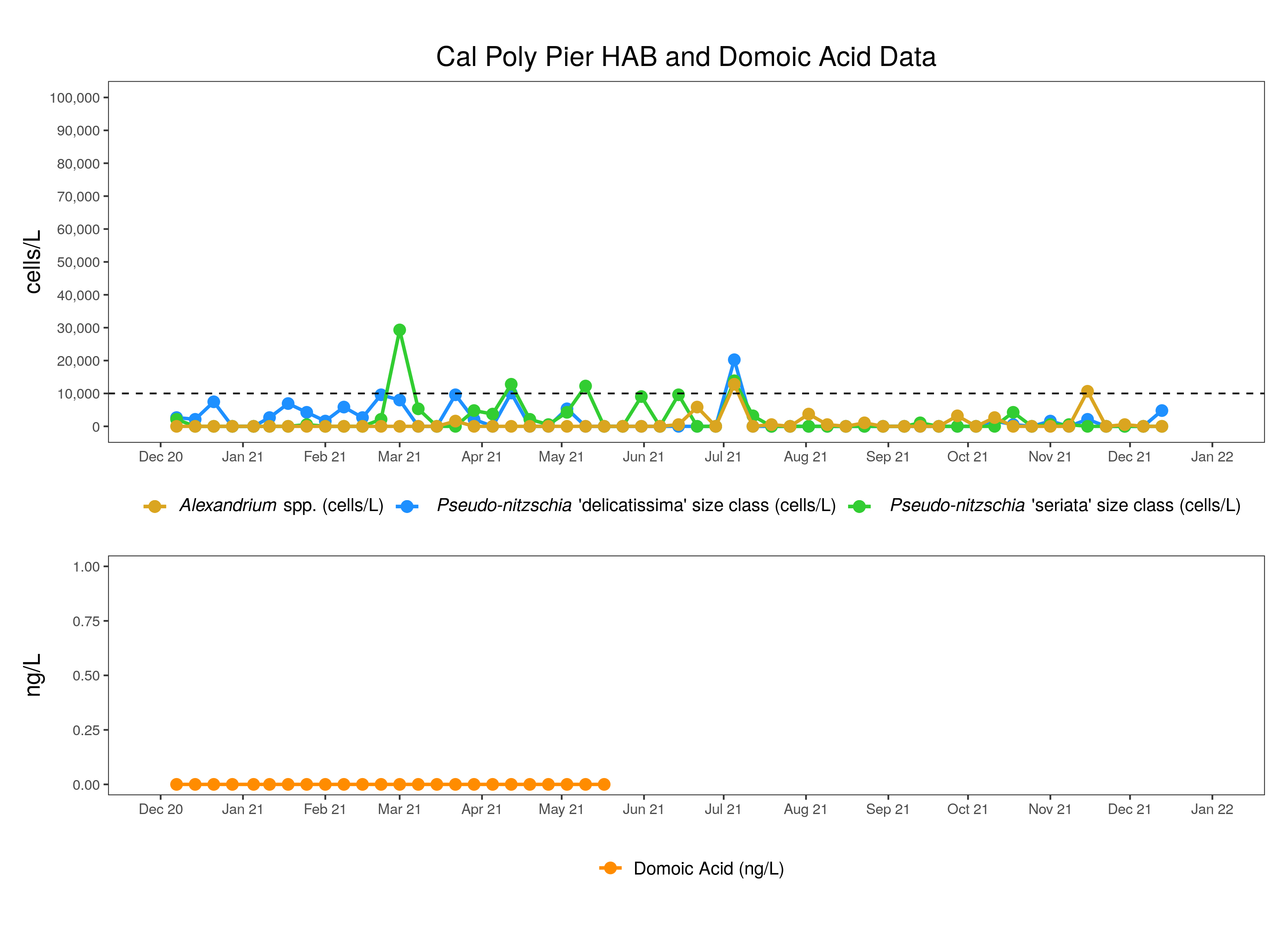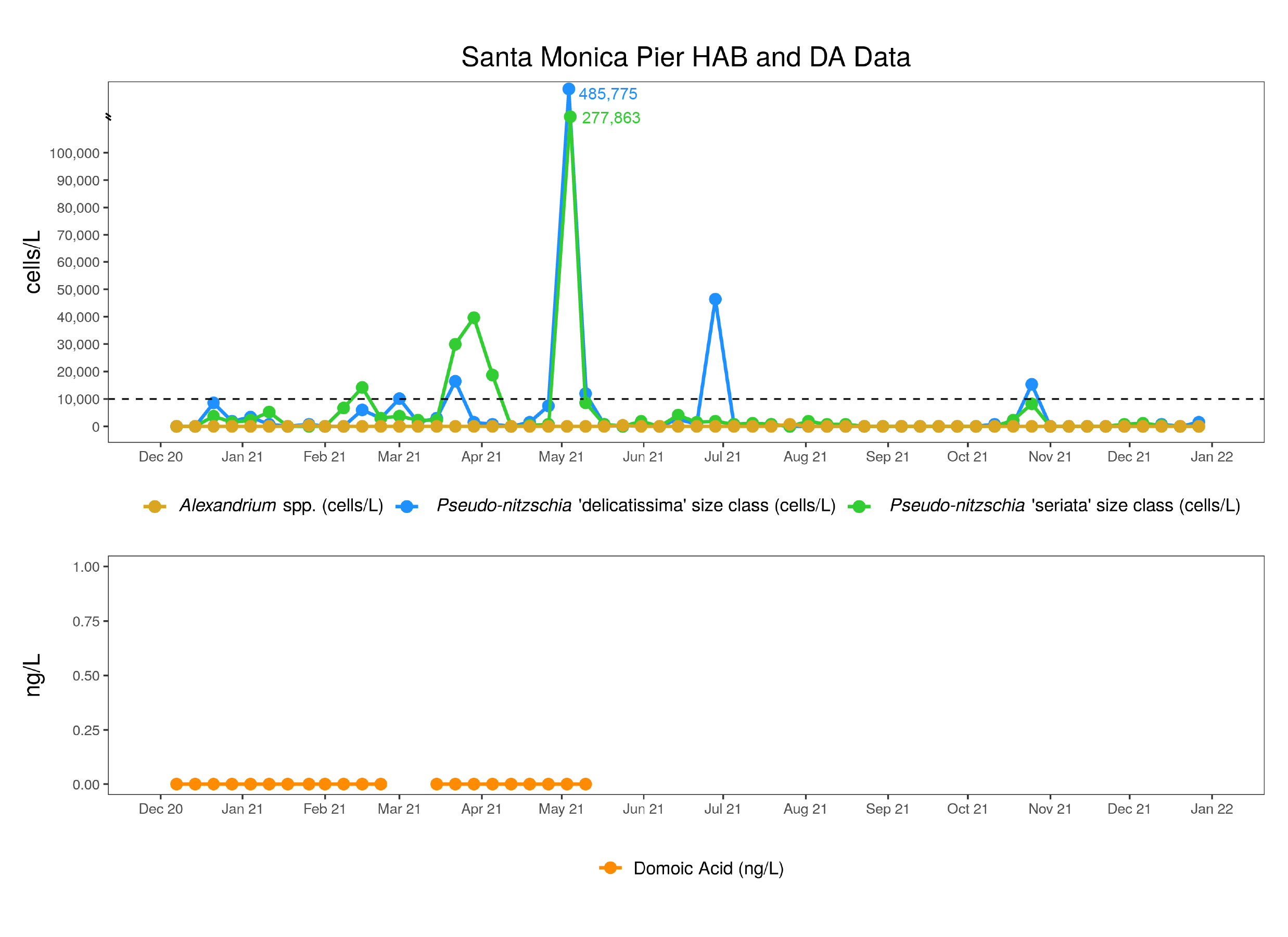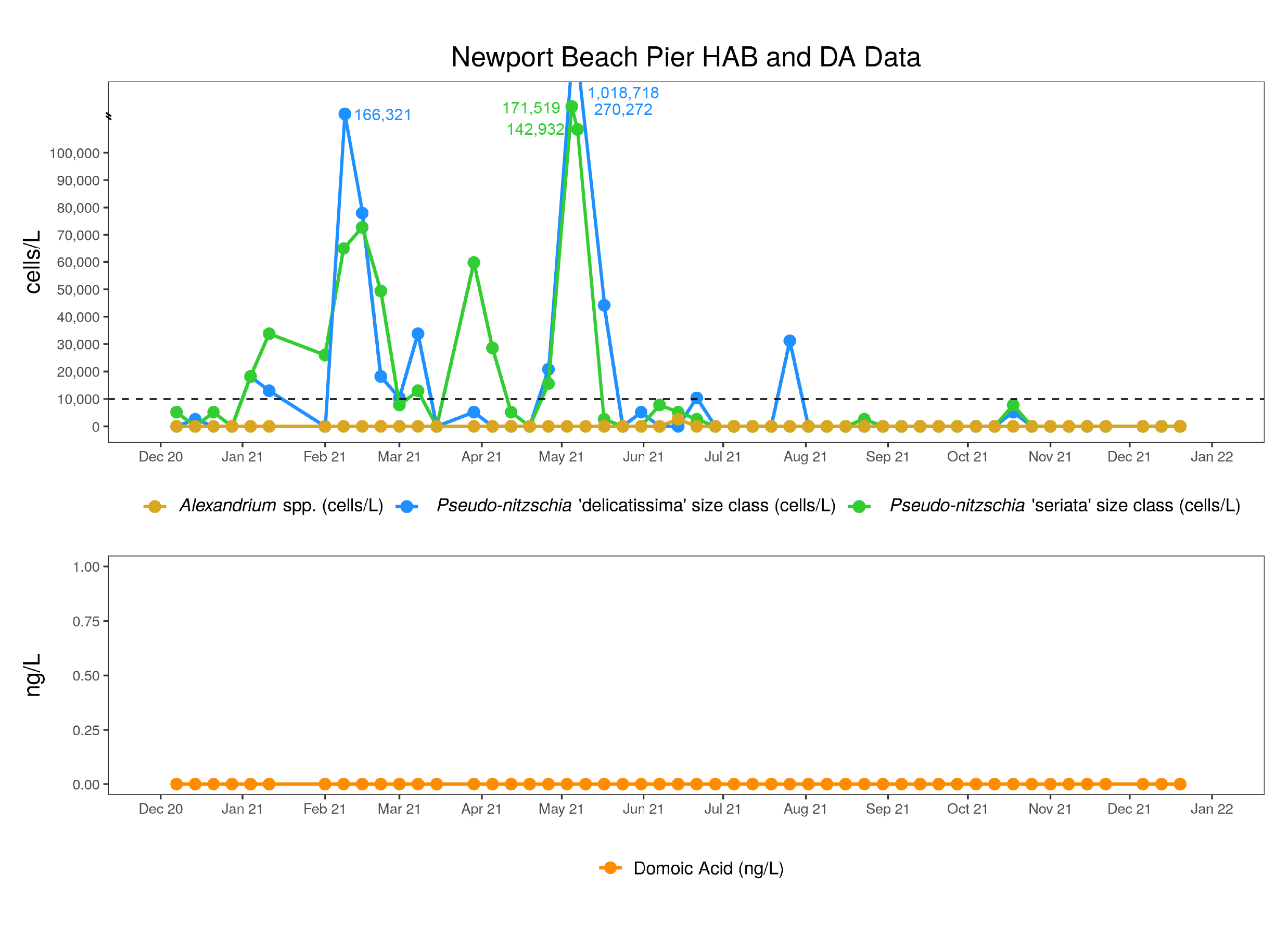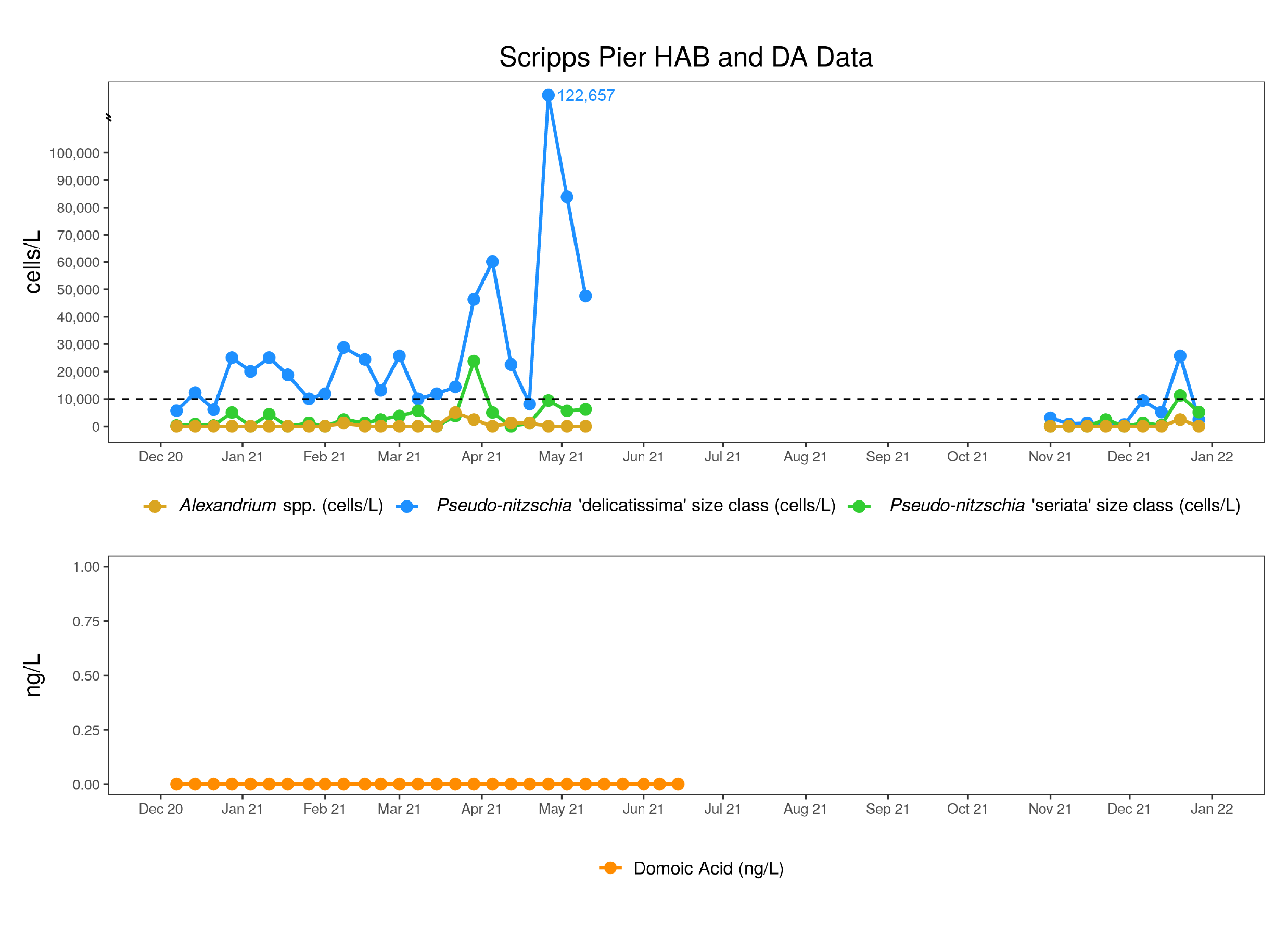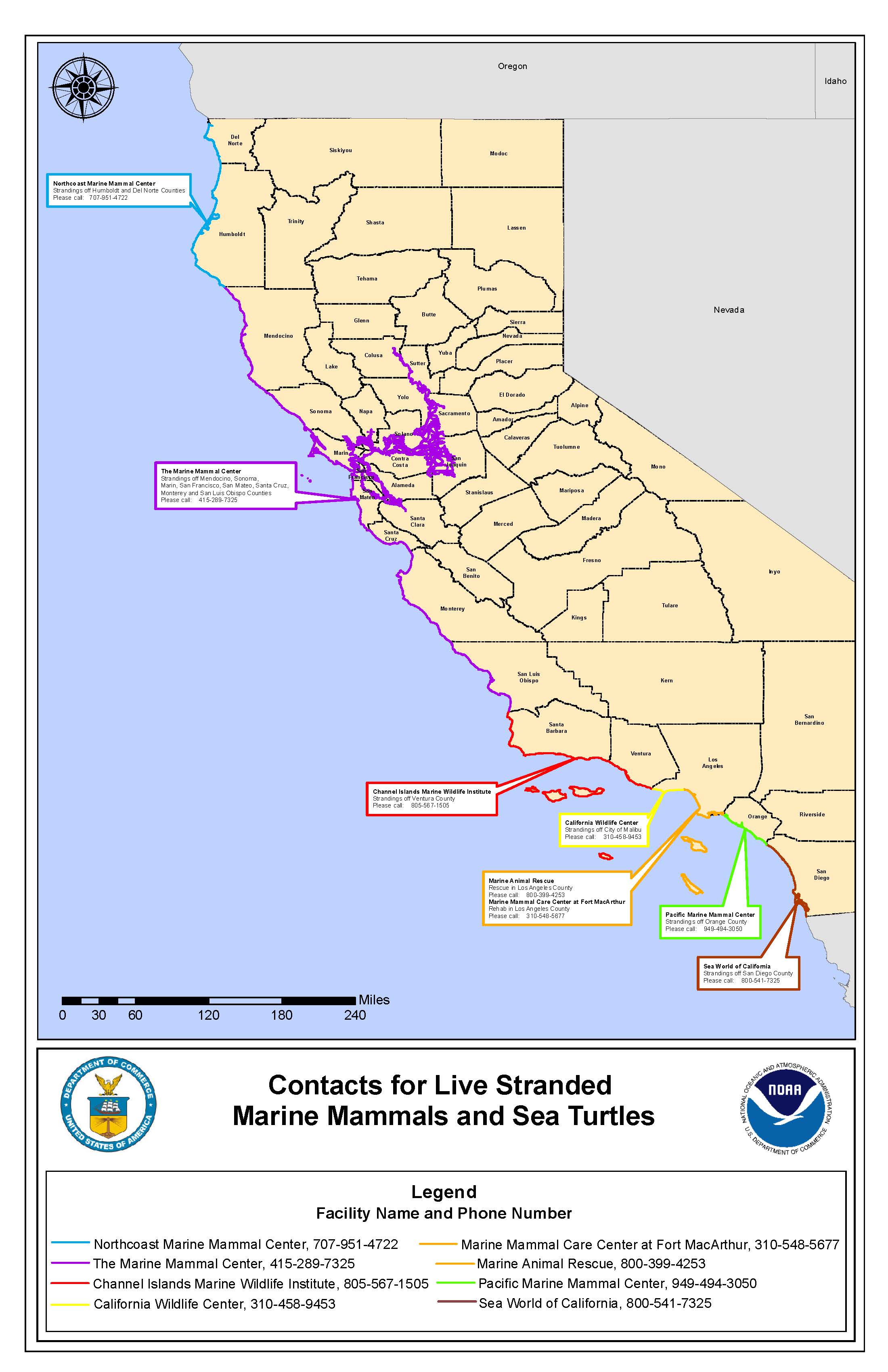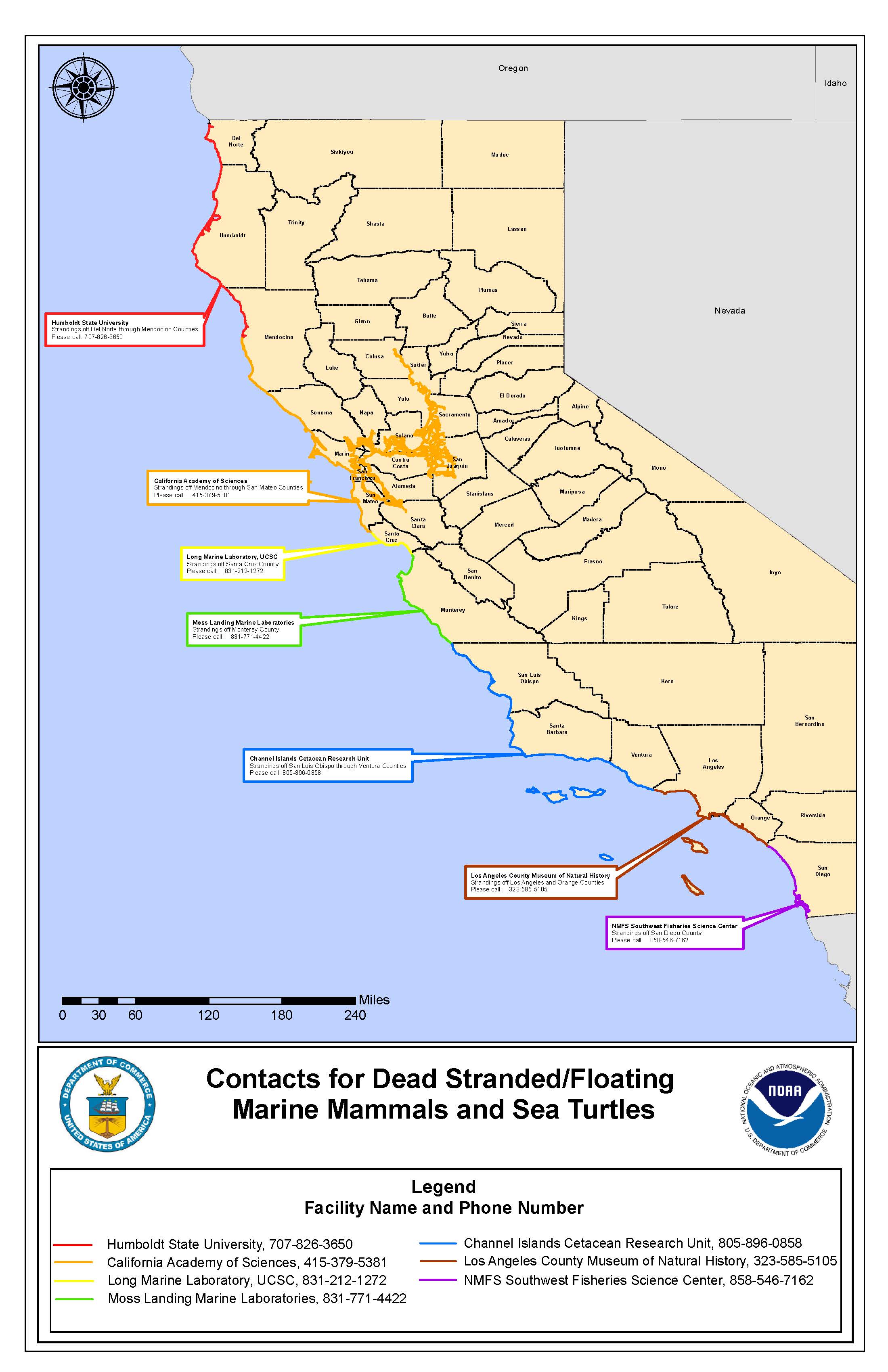DECEMBER HIGHLIGHTS
Pseudo-nitzschia -
- C-HARM tells us where conditions are suitable for species of the diatom Pseudo-nitzschia spp. (all size classes) to grow well and where they might be more likely to produce the deadly neurotoxin, domoic acid (DA).
- C-HARM predictions in December were similar to October and November for Pseudo-nitzschia spp., suggesting widespread habitat suitability throughout the state, with very high bloom probabilities predicted for the entire coast out to many 100s of kilometers offshore, although contracting back towards a narrow swath at the end of the month.
- Compared to the quiescence in November at HABMAP pier sampling sites, Pseudo-nitzschia spp. were measured at bloom levels at both Stearns Wharf and Scripps Pier for both size classes. Pseudo-nitzschia spp. were detected at all other sites throughout the month, except for Newport Pier.
- Domoic acid data are currently reported for only one sampling date in December at Santa Cruz Wharf, and that sample was below detection (i.e. no detectable DA). DA data for the other HABMAP pier sites were not yet available, a time lag that persists due to COVID-19 lab restrictions but is expected to speed up to a monthly time series in early 2022.
- Pseudo-nitzschia activity from CDPH sampling painted a slightly different picture than HABMAP, in that the toxigenic 'seriata' size class was "Common" at two sites in central CA -- Diablo Cove and Morro Bay -- while Cal Poly Pier (in the same general region) only saw low levels of the P. 'delicatissima' size class in December. All other sites sampled by CDPH in December detected P. 'seriata' at a Relative Abundance Index (RAI) below 20%, even at sites near HABMAP piers where bloom levels of P. 'seriata' were recorded. This difference underscores the high variability in the system and the somewhat ephemeral nature of some spikes in one taxonomic group vs. another.
- C-HARM probabilities in December for particulate domoic acid (pDA) were muted relative to the previous month, a pattern that is expected as winter approaches. Highest probabilities occurred in and around the Santa Barbara Channel, including offshore of Pt. Conception and into the San Luis Obispo Co. coast, further south in offshore areas of the Bight, and further north outside the Golden Gate (SF Bay). An ephemeral pDA event was predicted in the Monterey Bay mid-month.
- Continuing with the trend seen in November towards a weakening of cellular domoic acid (cDA) probabilities, C-HARM predictions for cDA events in December were overall patchy and confined to relatively small areas of the coastline. The problem areas along the North Coast were predicted to be around Pt. Arena as well as the southern Oregon zone earlier in the month and then moved to the Marin and Sonoma Co. coast (mostly offshore) and outside the Golden Gate (similar to pDA patterns). In contrast with pDA predictions, cDA probabilities never exceeded 70% in the Southern California Bight.
- Only two marine mammal strandings were recorded from potential DA toxicosis in the month of December: Monterey (Dec 3) and Santa Cruz (Dec 19). The Dec 3rd stranding may be a result of the previous two weeks or more of feeding in the region since we did see hot spots around Monterey Bay for DA events from the C-HARM predictions in late November. C-HARM also suggested hot spots in Monterey Bay 12-14 Dec, which could possibly explain the Santa Cruz stranding, although note that this animal may have been foraging further north in potential hot spots such as that in the SF/Marin/Sonoma County region.
- On Dec 16th, the CDPH issued a health advisory not to eat razor clams caught recreationally in Del Norte County due to the threat of ASP from domoic acid; this may be connected to the high DA predictions coming from the North Coast in previous months and the southern Oregon hot spot noted in December.
Alexandrium -
- CDPH noted that Alexandrium spp. were "Present" at sites in central and southern California in December, corroborating HABMAP detection of Alexandrium spp. at Scripps Pier and Santa Cruz Wharf, the latter site also picking up Alexandrium in November. There are currently no advisories for Paralytic Shellfish Poisoning.
*Please note that HABMAP sampling, CDPH sampling, and marine mammal rescues have been greatly reduced in response to COVID-19 safety measures.
Summary written by Clarissa Anderson on January 12, 2022
**HABMAP sampling resumed after being suspended in March 2020 in accordance with the Governor's stay at home order. However, COVID-19 safety protocols and sampling restrictions may continue to affect operations and delay results.**
Note that data for some stations are not shown because they are not yet recorded in the public HABMAP archive.
Differentiating Pseudo-nitzschia species by light microscopy is difficult. For this reason, Pseudo-nitzschia "seriata" does not refer to an actual species but rather the larger size class of Pseudo-nitzschia, which is generally a more toxigenic group of species. Alternatively, Pseudo-nitzschia "delicatissima" refers to the smaller size class that is generally non-toxigenic. The dashed line on the plots demarcates the 10,000 cells/L "bloom" threshold designated here for Pseudo-nitzschia populations only.
More information and data visualizations on the statewide HAB network and forecasting system can be found on the California HABMAP website and on the SCCOOS Harmful Algal Bloom page.
Santa Cruz Wharf
Three water samples were collected at Santa Cruz Wharf in December. Molecular probes for toxigenic Pseudo-nitzschia in the "seriata" class are conducted for this site, and was detected on each occasion (December 1, 8, 15) below the bloom threshold. Alexandrium spp. were detected twice (December 1, 8). Domoic acid was not detected but 2 samples are still pending analysis.
The Santa Cruz Wharf shore station is supported by CeNCOOS PI Raphael Kudela at UCSC.
Monterey Wharf
Two water samples were collected at Cal Poly Pier in December. Pseudo-nitzschia "delicatissima" was detected once (December 13) below the bloom threshold. Pseudo-nitzschia "seriata" and Alexandrium spp. were not detected. Domoic acid results are not yet available.
Cal Poly Pier shore station is supported by SCCOOS and PIs Ryan Walter and Ally Pasulka at Cal Poly.
Stearns Wharf
Three water samples were collected at Stearns Wharf in December. Pseudo-nitzschia "delicatissima" and Pseudo-nitzschia "seriata" were detected on each occasion (December 6, 12, 19), with samples from December 12th above the bloom threshold. Alexandrium spp. and domoic acid were not detected.
Stearns Wharf is supported by SCCOOS and PIs Mark Brzezinski and Libe Washburn at UCSB.
Santa Monica Pier
Four water samples were collected at Santa Monica Pier in December. Pseudo-nitzschia "delicatissima" was detected twice (December 13, 27) below the bloom threshold. Pseudo-nitzschia "seriata" was also detected twice (December 6, 13) below the threshold. Alexandrium spp. and domoic acid (not shown on plot) were not detected.
The Santa Monica Pier shore station is supported by SCCOOS and PI Rebecca Shipe at UCLA.
Newport Beach Pier
Three water samples were collected at Newport Beach Pier in December. Pseudo-nitzschia "delicatissima", Pseudo-nitzschia "seriata", Alexandrium spp., and domoic acid were not detected.
Newport Beach Pier is supported by SCCOOS and PI David Caron at USC.
Scripps Pier
Four water samples were collected at Scripps Pier in December. Pseudo-nitzschia "delicatissima" and Pseudo-nitzschia "seriata" were detected on each occasion (December 6, 13, 20, 27), with the December 20th samples above the bloom threshold. Alexandrium spp. were detected once also on December 20. Domoic acid results are not yet available.
Scripps Pier is supported by SCCOOS and PIs Melissa Carter and Clarissa Anderson at UCSD.
CDPH observations for Pseudo-nitzschia "seriata" and Alexandrium spp.
You can view the interactive map and data table of California Department of Public Health (CDPH) data from January 2019 to present, developed by SCCOOS, below. Or, view CDPH Toxic Phytoplankton Observations Map with layers of Pseudo-nitzschia and Alexandrium spp. as well as other phytoplankton species observations (in the pop-up windows).
Data are provided by the Environmental Management Branch of the CDPH. Please note, starting in July 2019, CDPH moved to only reporting Pseudo-nitzschia of the seriata complex and not all Pseudo-nitzschia spp. as previously provided.
Please email CDPH at Susan.Paulukonis@cdph.ca.gov for any potential marine HAB-related illness in humans.
From December 1-31 2021, water samples were collected by volunteers and sent to the California Department of Public Health (CDPH) for analysis.
Pseudo-nitzschia "seriata" group was detected in 36 of the 78 samples:
Pseudo-nitzschia "seriata" was detected at "Common" density levels on 3 occasions:
- 2021-12-17 20% Port San Luis, Diablo Cove
- 2021-12-21 10% Port San Luis, Diablo Cove
- 2021-12-22 15% Morro Bay, North T-Pier
Pseudo-nitzschia "seriata" was detected at "Present" density levels on 18 occasions:
- 2021-12-01 2% Imperial Beach Pier
- 2021-12-01 5% Monterey Bay, Commercial Wharf
- 2021-12-02 4% Drakes Bay, Chimney Rock LBS
- 2021-12-06 1% La Jolla, Scripps Pier
- 2021-12-06 5% Pacifica Pier
- 2021-12-07 1% Mendocino, Noyo Harbor
- 2021-12-10 2% Bolsa Chica
- 2021-12-10 7% San Simeon Pier
- 2021-12-17 3% Santa Barbara, Mohawk Reef
- 2021-12-17 3% Santa Barbara Ch., Naples Pt
- 2021-12-18 2% Santa Cruz Wharf
- 2021-12-19 3% Pacifica Pier
- 2021-12-20 1% Agua Hedionda Lagoon
- 2021-12-20 1% La Jolla, Scripps Pier
- 2021-12-22 7% Imperial Beach Pier
- 2021-12-27 2% La Jolla, Scripps Pier
- 2021-12-28 1% Imperial Beach Pier
- 2021-12-30 1% Drakes Bay, Chimney Rock LBS
Pseudo-nitzschia "seriata" was detected at "Rare" density levels on 15 occasions:
- 2021-12-01 0.5% Bodega Harbor, USCG Dock
- 2021-12-03 0.5% Pismo Pier
- 2021-12-06 0.5% Tomales Bay, Lease #M430-15
- 2021-12-08 0.5% Santa Cruz Wharf
- 2021-12-08 0.5% Bolinas Lagoon
- 2021-12-08 0.5% Goleta Pier
- 2021-12-13 0.5% Tomales Bay, Lease #M430-15
- 2021-12-13 0.5% Monterey Bay, Commercial Wharf
- 2021-12-14 0.5% Drakes Bay, Chimney Rock LBS
- 2021-12-15 0.5% Santa Cruz Wharf
- 2021-12-20 0.5% Tomales Bay, Lease #M430-15
- 2021-12-28 0.5% Tomales Bay, Lease #M430-15
- 2021-12-28 0.5% Tomales Bay, Lease #M430-15
- 2021-12-29 0.5% Goleta Pier
- 2021-12-31 0.5% Port San Luis, Diablo Cove
Alexandrium spp.were detected in 14 of the 78 samples:
Alexandrium spp. were not detected at "Common" density level.
Alexandrium spp. were detected at "Present" density levels on 6 occasions:
- 2021-12-08 1% Goleta Pier
- 2021-12-21 1% Port San Luis, Diablo Cove
- 2021-12-21 6% Goleta Pier
- 2021-12-22 3% Morro Bay, North T-Pier
- 2021-12-28 1% Imperial Beach Pier
- 2021-12-31 5% Port San Luis, Diablo Cove
Alexandrium spp. were detected at "Rare" density levels on 8 occasions:
- 2021-12-03 0.5% Pismo Pier
- 2021-12-07 0.5% San Diego Bay, U.S. Navy Pier
- 2021-12-10 0.5% San Simeon Pier
- 2021-12-14 0.5% Drakes Bay, Chimney Rock LBS
- 2021-12-15 0.5% Imperial Beach Pier
- 2021-12-17 0.5% Santa Barbara Ch., Naples Pt
- 2021-12-17 0.5% Port San Luis, Diablo Cove
- 2021-12-22 0.5% Imperial Beach Pier
CDPH and OEHHA Health Advisories
December 16. The California Department of Public Health (CDPH) is advising consumers not to eat sport-harvested razor clams from Del Norte County due to dangerous levels of naturally occurring domoic acid, also referred to as Amnesic Shellfish Poisoning, being detected.
November 29. The California Department of Public Health (CDPH) has lifted the shellfish safety notification for Dungeness crab caught in state waters from the Sonoma/Mendocino County Line (38° 46.125' N. Latitude) to Point Reyes (38° N. Latitude) in Marin County.
November 5. Due to the detection of elevated levels of domoic acid, a naturally occurring toxin, the California Department of Public Health (CDPH) is warning consumers not to eat the viscera (internal organs) of Dungeness crab caught in coastal waters.
For the latest closures and updates, please visit the CDPH Health Advisories page as a central location of information related to CDPH health advisories. Also available is a map showing the current CDPH Recreational Bivalve Shellfish Advisories (see below).
NEWS: The HAB-related illness workgroup has developed a new webpage for marine HAB-related illness tracking work (https://oehha.ca.gov/fish/general-info/marine-harmful-algal-bloom-hab-related-illness-tracking).
Domoic acid (DA) is a potent neurotoxin produced by some diatom species of the genus Pseudo-nitzschia. Species exposed to DA can result in seizures, epilepsy, cardiomyopathy, and death depending upon the ingested dose. DA toxicosis commonly occurs in California Sea Lions (Zalophus californianus), presumably due to a combination of foraging behavior and seasonal movements. The Marine Mammal Center (TMMC), Channel Islands Marine Wildlife Institute (CIMWI), California Wildlife Center (CWC), Marine Mammal Care Center Los Angeles (MMCC-LA), Marine Animal Rescue (MAR), the Pacific Marine Mammal Center (PMMC), and SeaWorld act like an emergency room by working to rescue and rehabilitate sick and injured marine mammals, seabirds, and sea turtles.
The CWC, PMMC, MMCCLA, CIMWI, SeaWorld, and MAR did not record any strandings due to suspected domoic acid in December 2021.
December strandings due to suspected DA toxicosis occurred in the following counties:
- Monterey (TMMC)
- December 3 - subadult, male, California Sea Lion
- Santa Cruz (TMMC)
- December 19 - adult, female, California Sea Lion
At this time we do not have data from the North Coast Marine Mammal Center.
Please subscribe to CA HAB Bulletin listserv to receive the monthly CA HAB Bulletin.

